Olá Windows Insiders, hoje estamos lançando o Windows 11 Insider Preview Build 22557 para o Dev Channel.
TL;DR
Os Windows Insiders perceberão que o nome da ramificação da qual estamos lançando compilações foi alterado para NI_RELEASE. A ramificação na qual lançamos compilações para Insiders no Dev Channel é irrelevante para os recursos e melhorias incluídos nelas. Daqui para frente, não estaremos mais notando quando essas mudanças de ramificação ocorrerem. Para saber mais sobre nossa abordagem de como lançamos coisas para o Dev Channel, leia esta postagem do blog aqui.
Esta compilação não será oferecida para PCs ARM64. Esperamos poder oferecer uma nova versão para Insiders em PCs ARM64 em breve.
Esta compilação inclui um punhado de novos recursos para os Insiders tentarem incluir pastas na área de aplicativos fixados de Iniciar, legendas ao vivo, uma nova experiência de foco, melhorias de acesso rápido no Explorador de arquivos, novos gestos de toque e muito mais.
Essa compilação também inclui muitas melhorias e refinamentos gerais no Windows 11.
Temos alguns novos problemas conhecidos para alguns dos novos recursos e melhorias que estão sendo introduzidos com esta versão, portanto, leia os problemas conhecidos abaixo antes de enviar comentários.
Estamos tornando mais rápido o acesso aos seus aplicativos Android recentes em seu telefone a partir do aplicativo Seu Telefone. Detalhes abaixo.
Junte-se a nós na terça-feira, 22 de fevereiro, às 10h PST / 18h UTC para nosso próximo webcast do Windows Insider! Discutiremos "Apresentando comentários sobre os erros difíceis", falaremos sobre logs que podem ser úteis e compartilharemos links de conteúdo que você pode consultar. Marque na sua agenda e sintonize!
O que há de novo no Build 22557
Crie e organize pastas na área de aplicativos fixados de Iniciar
Ouvimos de muitos de vocês que gostariam de personalizar seus pins no Start organizando-os em pastas, por isso estamos apresentando a primeira versão de pastas nesta compilação. Basta arrastar um aplicativo em cima de outro para criar uma pasta. Você pode adicionar mais aplicativos a uma pasta, reorganizar aplicativos em uma pasta e remover aplicativos de uma pasta. Fique de olho em outras melhorias, como a capacidade de nomear e renomear pastas em uma de nossas próximas compilações.
Comece a mostrar os aplicativos fixados organizados em pastas.
Comece a mostrar os aplicativos fixados organizados em pastas.
FEEDBACK: Envie comentários no Hub de Feedback (WIN + F) em Ambiente de Trabalho > menu Iniciar.
Apresentando Não perturbe e foco
Reinventamos as experiências de foco no Windows. Não perturbe facilita o silenciamento das notificações. O Focus é uma nova experiência que permite que todos permaneçam no momento e minimizem as distrações em seus PCs. Para ajudá-lo a manter o foco, o foco se integra ao aplicativo Relógio para outras ferramentas de foco, como um temporizador de foco e música calmante.
Não perturbe:
Agora é mais fácil do que nunca silenciar banners de notificação com não perturbe. Quando estiver pronto para ver as notificações que você pode ter perdido, você poderá encontrá-las na Central de Notificações.
Como não perturbe aparece quando ativado na Central de Notificações.
Como não perturbe aparece quando ativado na Central de Notificações.
Você está sempre no controle de suas notificações. Em Configurações > Sistema > Notificações, você pode configurar regras para ativar automaticamente o não perturbe. Por exemplo, você pode definir não perturbe para ativar automaticamente fora do horário de trabalho. Além disso, você pode definir notificações prioritárias para controlar se chamadas, lembretes e aplicativos específicos são interrompidos quando não perturbe está ativado.
Você pode personalizar o não perturbe em Configurações > Sistema > Notificações.
Você pode personalizar não perturbe em Configurações.
Foco:
É fácil iniciar o foco diretamente da Central de Notificações (clique na hora e data na barra de tarefas):
Abra o Centro de Notificações.
Selecione a quantidade de tempo para sua sessão de foco.
Pressione Iniciar Foco.
Sessão de foco em andamento com o emblema da barra de tarefas desativado, o temporizador de foco na tela e não perturbe serão ativados.
Sessão de foco em andamento com o emblema da barra de tarefas desativado, o temporizador de foco na tela e não perturbe serão ativados.
Quando você inicia uma sessão de foco, o emblema da barra de tarefas será desativado, o flash de aplicativos na barra de tarefas será desativado, um cronômetro de foco aparecerá na tela e não perturbe será ativado. O foco no Windows se integra às sessões de foco no aplicativo Relógio, para que você possa tocar música calmante e ver uma lista de tarefas do Microsoft To-Do. Quando sua sessão de foco terminar, você receberá uma notificação informando que seu tempo de foco foi concluído. Você pode personalizar sua experiência de foco (Configurações > Sistema > Foco).
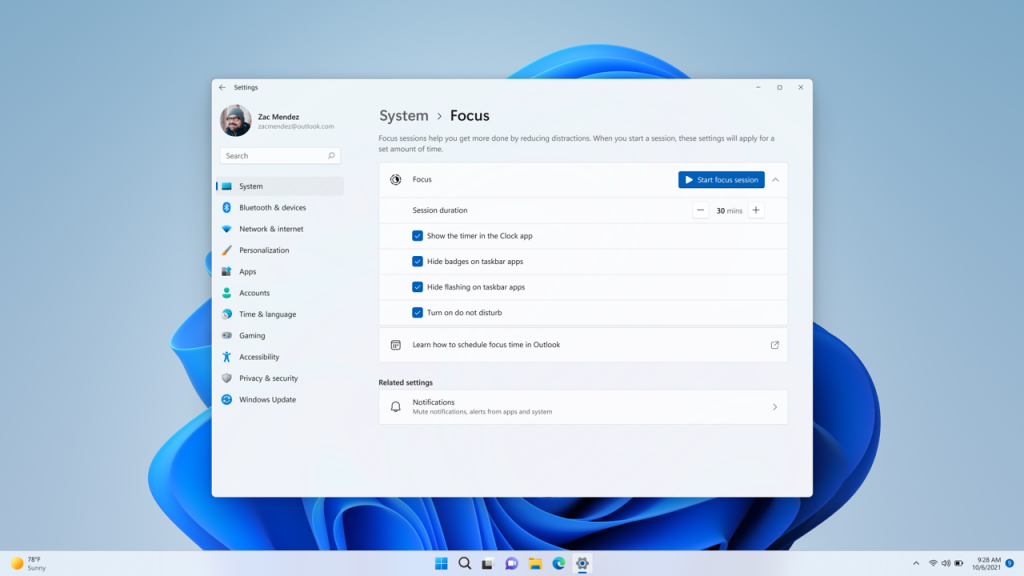
FEEDBACK: Please file feedback in Feedback Hub (WIN + F) under Desktop Environment > Focus.
Live Captions
Live captions will help everyone, including people who are deaf or hard of hearing, better understand audio by viewing captions of spoken content. Captions are automatically generated on-device from any content with audio. Captions can be displayed at the top or bottom of the screen, or in a floating window. The caption window can be resized, and caption appearance can be personalized by applying or customizing a caption style. Microphone audio can be included, which can be helpful during in-person conversations. Live captions support English (U.S.) content.
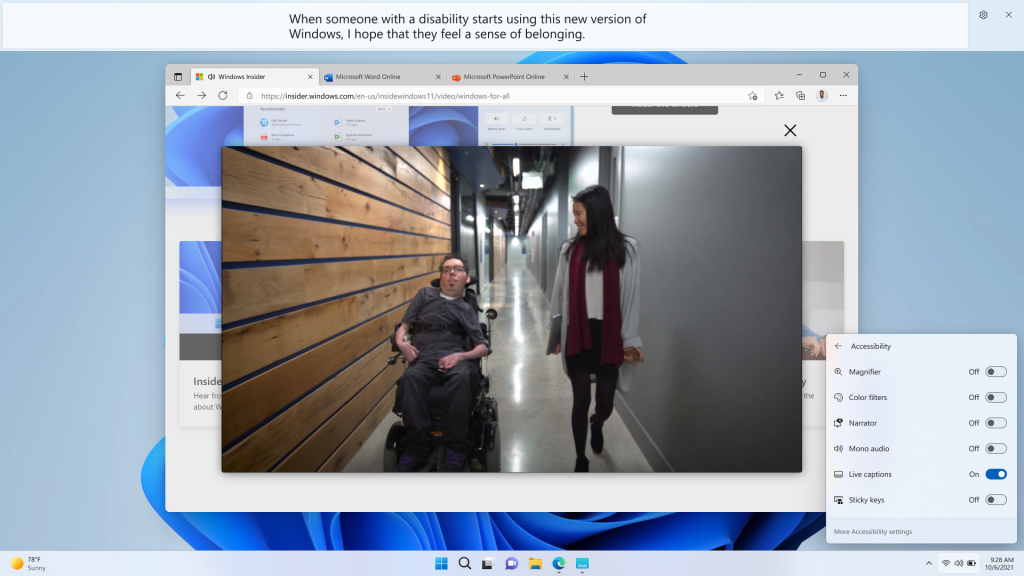
To get started, live captions can be turned on with the WIN + Ctrl + L keyboard shortcut, or from the Accessibility flyout under Quick Settings. When turned on the first time, live captions will prompt for download of the required speech model to enable on-device captioning.
FEEDBACK: Please file feedback in Feedback Hub (WIN + F) under Accessibility > Live captions.
Improving Quick Access in File Explorer
We are rolling out an update to File Explorer’s Quick Access view. First, “Pin to Quick Access” support has been extended from only supporting Folders to now also supporting Files. Pinned files are shown in a new section above Recent files in Quick Access.
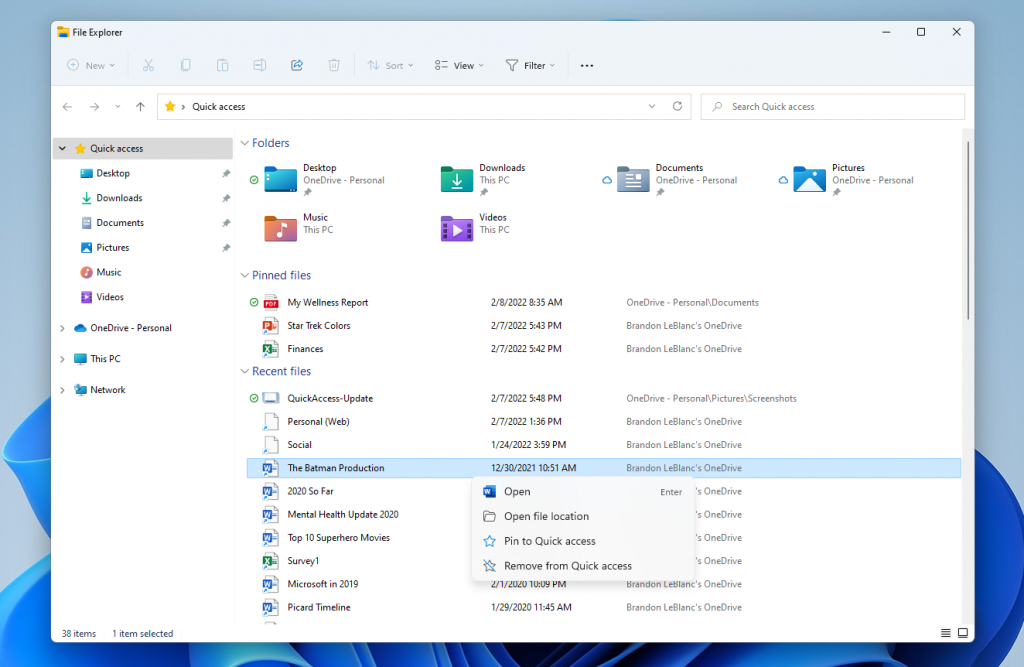
Next, for users who log into Windows with (or attach as a secondary account) a Microsoft Account or Work/Education account, Pinned and Recent files from Office.com will also be shown in Quick Access. Changes that pin or unpin files hosted in OneDrive, SharePoint, and Teams will sync and be reflected in Office.com and Office apps. File activity updates from collaborators such as edits, and comments are shown in Tiles view and can also be shown in Details view.
FEEDBACK: Please file feedback in Feedback Hub (WIN + F) under Files, Folders, and Online Storage > File Explorer.
See your OneDrive storage in File Explorer
Backing up your files and managing your cloud storage is important for the safety of your stuff. To help you have control over storage consumption and ensure your files are syncing, we’ve added OneDrive integration into File Explorer. When browsing your OneDrive folders, you can now see your sync status and quota usage without having to leave File Explorer.
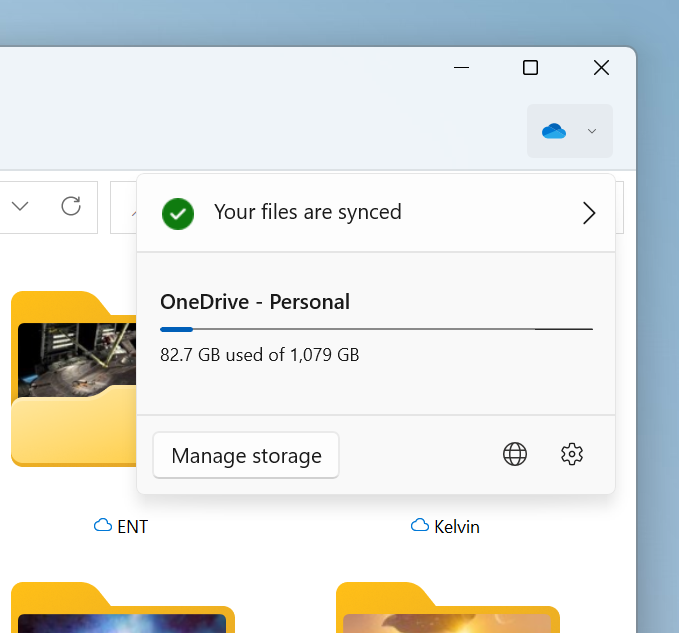
ALT-TEXT: OneDrive storage as shown in File Explorer when navigating to OneDrive folders.
FEEDBACK: Please file feedback in Feedback Hub (WIN + F) under Files, Folders, and Online Storage > File Explorer.
New Touch Gestures
This build includes 5 new touch gestures to make it easier and quicker to navigate Windows 11 on a PC with touch:
Swipe to invoke and dismiss Start: Swipe with your finger from the middle of the taskbar to invoke the Start menu and swipe back down to dismiss it.
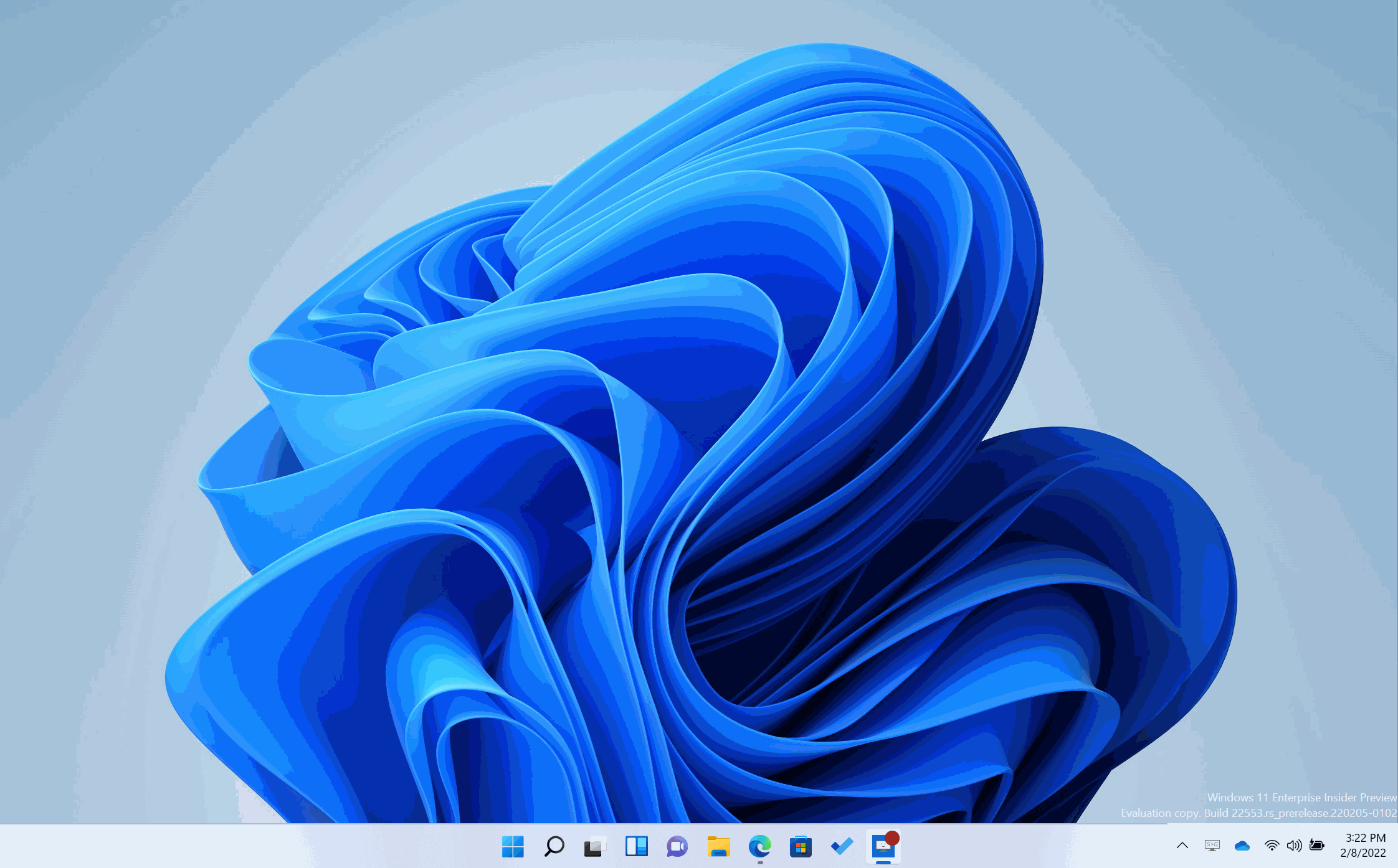
Swipe between Pinned/All apps and Recommended/More on Start: Within Start, swipe right to left from Pinned to get to All apps and left to right to get back to Pinned. The same gesture works for Recommended/More.
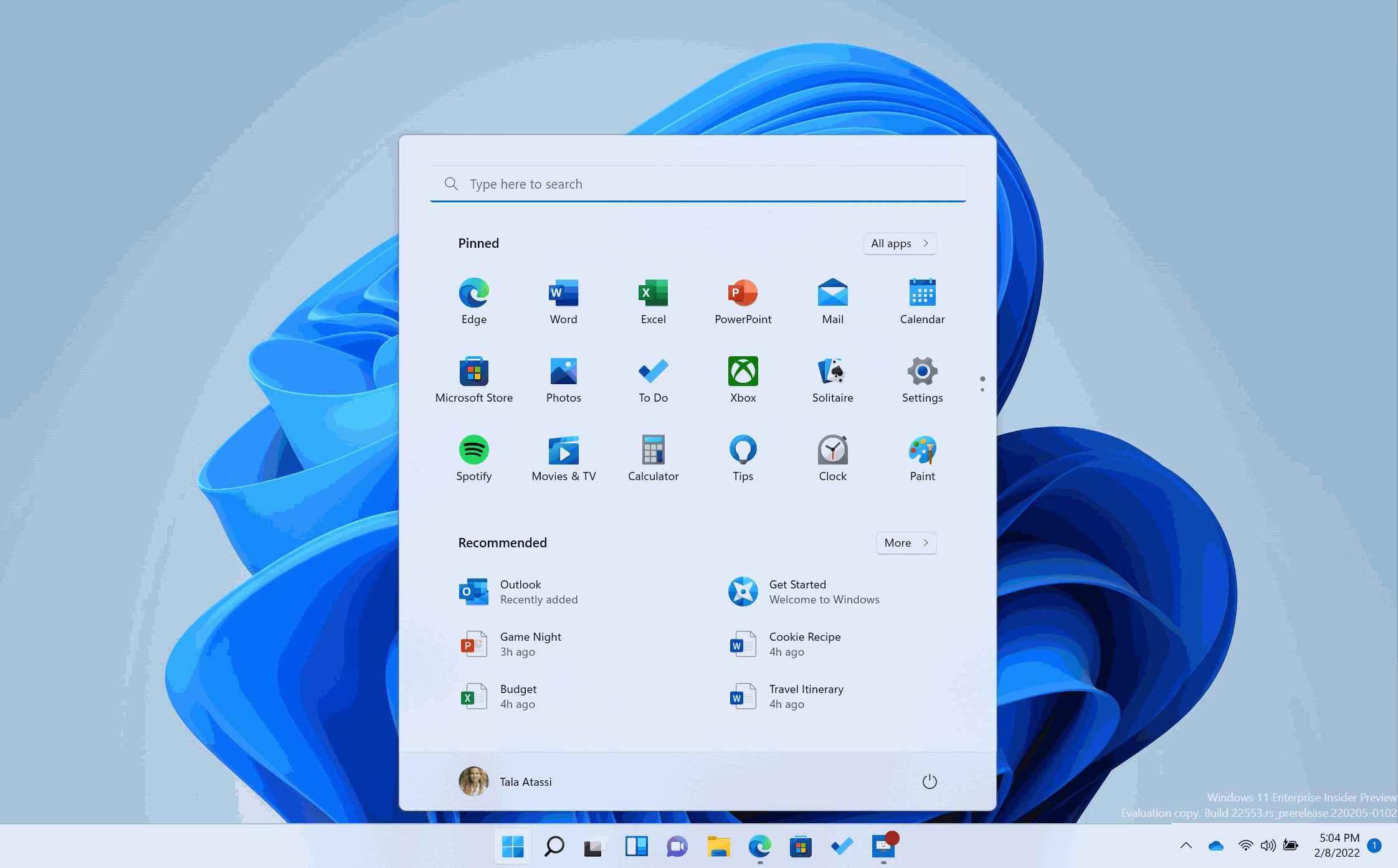
Swipe to invoke and dismiss Quick Settings: Swipe with your finger from the bottom right of the taskbar to invoke Quick Settings and swipe back down to dismiss it.
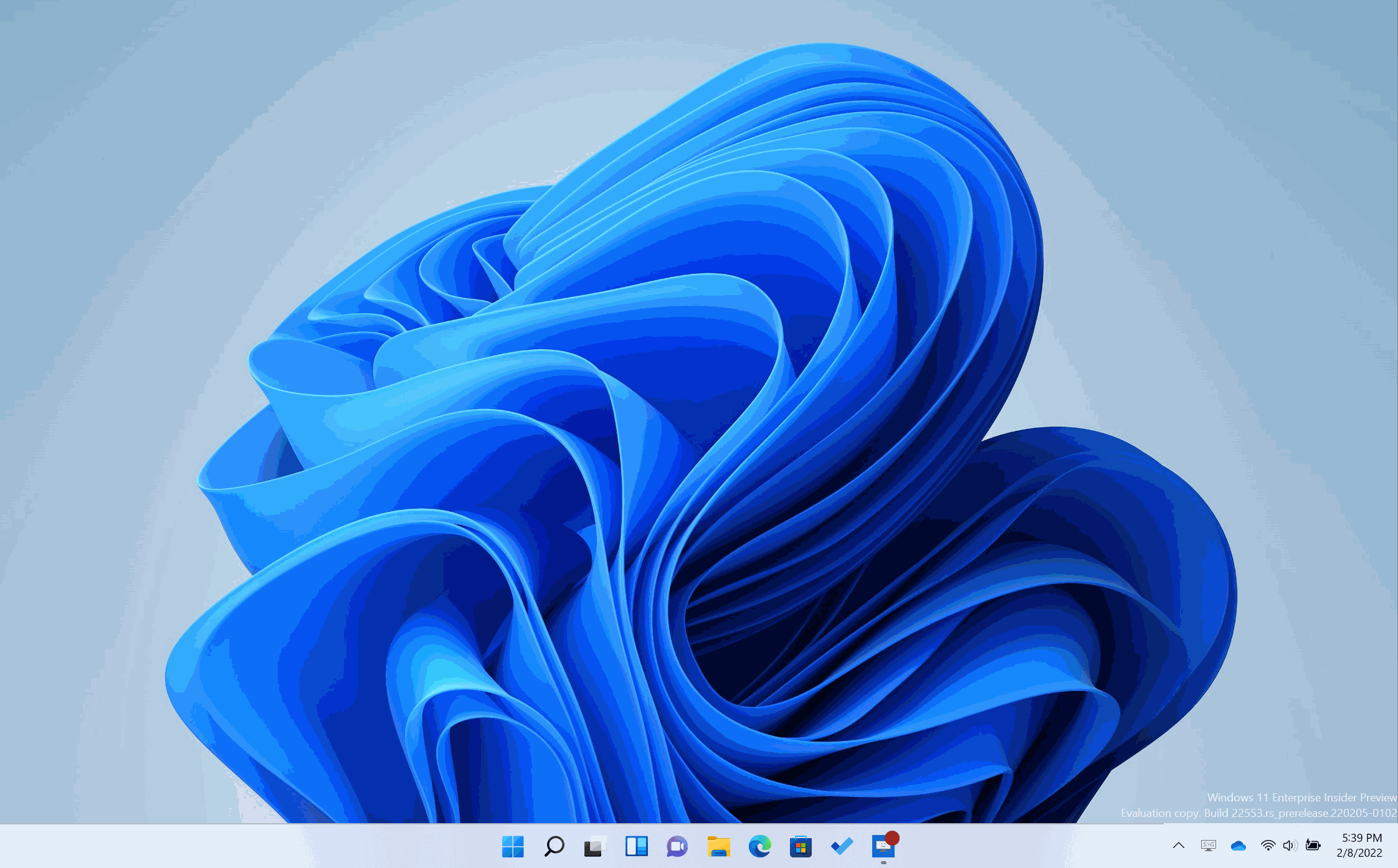
Swipe to invoke and dismiss Notification Center: We’ve updated the animation when swiping to invoke and dismiss Notification Center from the right edge of your screen so that it’s more responsive and follows your finger.
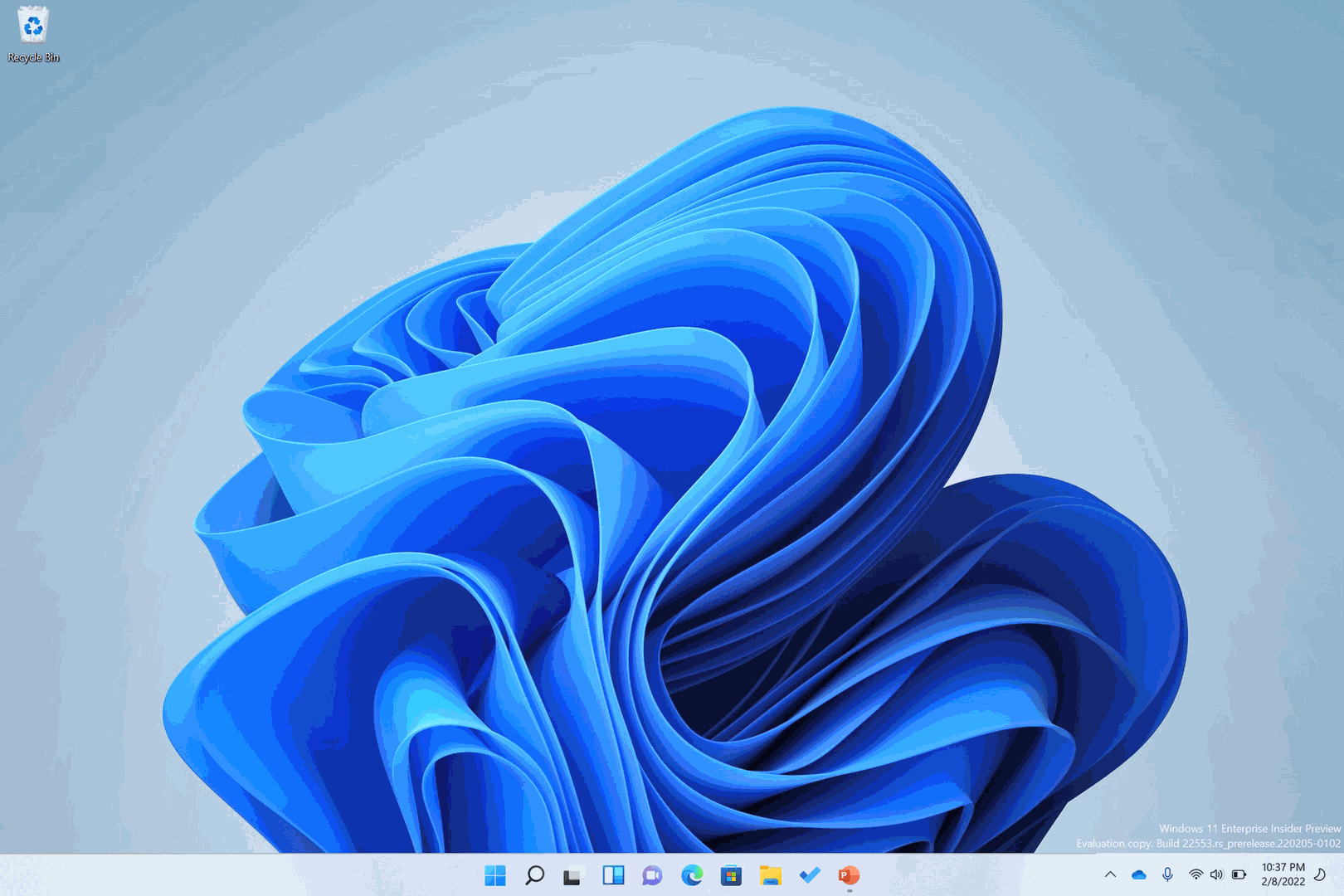
Full screen gripper: In full screen touch-oriented apps and games (e.g., Solitaire), notice a gripper that appears if you swipe from the edges of the screen. This feature is designed to keep you in your app if you accidentally swipe near the edges. If you need to access edge content, simply swipe again on the gripper.
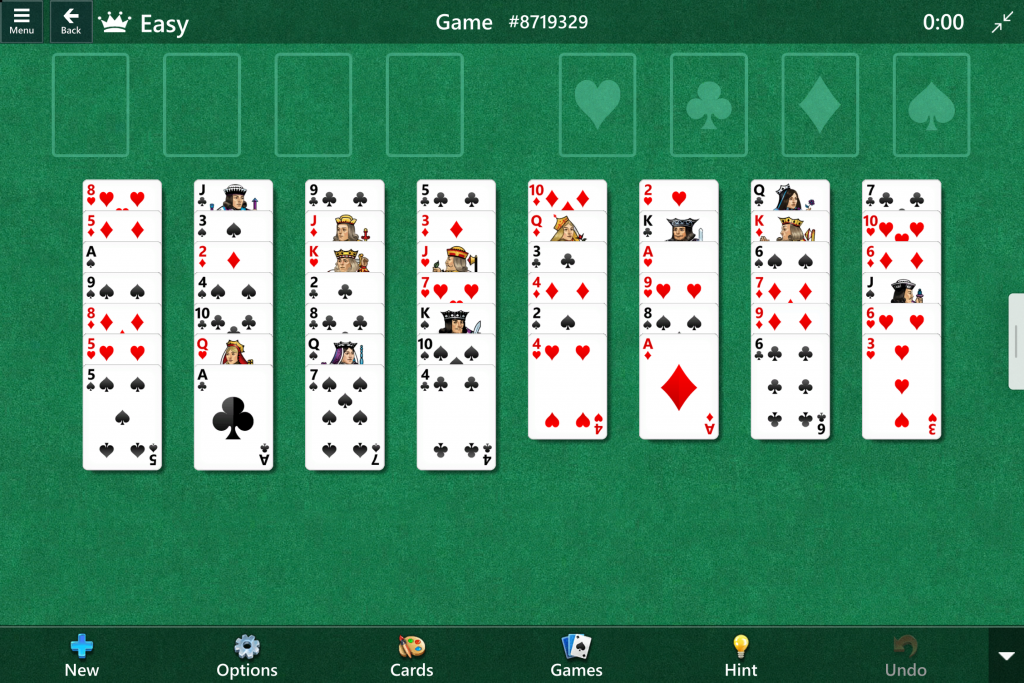
Note that these gestures are reversed in Right to Left languages. Any swipe from the right becomes a swipe from the left and vice versa.
FEEDBACK: Please file feedback in Feedback Hub (WIN + F) under Input and Language > Touch Input and Gestures.
Improving Snap Layouts
We’ve added a new way to snap windows into snap layouts that works wonderfully with both touch and mouse! To try it out, just drag a window to the top of the screen to reveal the snap layouts, drop the window on top of a zone to snap it, and use snap assist to finish building your layout.
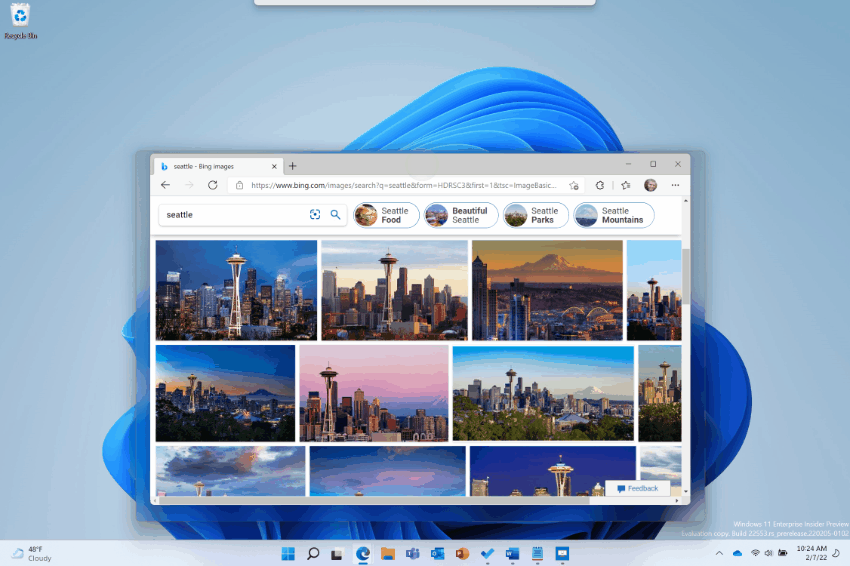
On top of all that, we’ve also improved snap assist to seamlessly animate between zones in a layout for a delightful end-to-end snapping experience.
FEEDBACK: Please file feedback in Feedback Hub (WIN + F) under Desktop Environment > Snap.
More sustainable power settings and recommendations
The default values for Sleep and Screen off have been updated to reduce energy consumption, and carbon emissions, when PCs are idle. We will also provide power saving recommendations to help reduce carbon emissions to those with Sleep and Screen off set to Never.
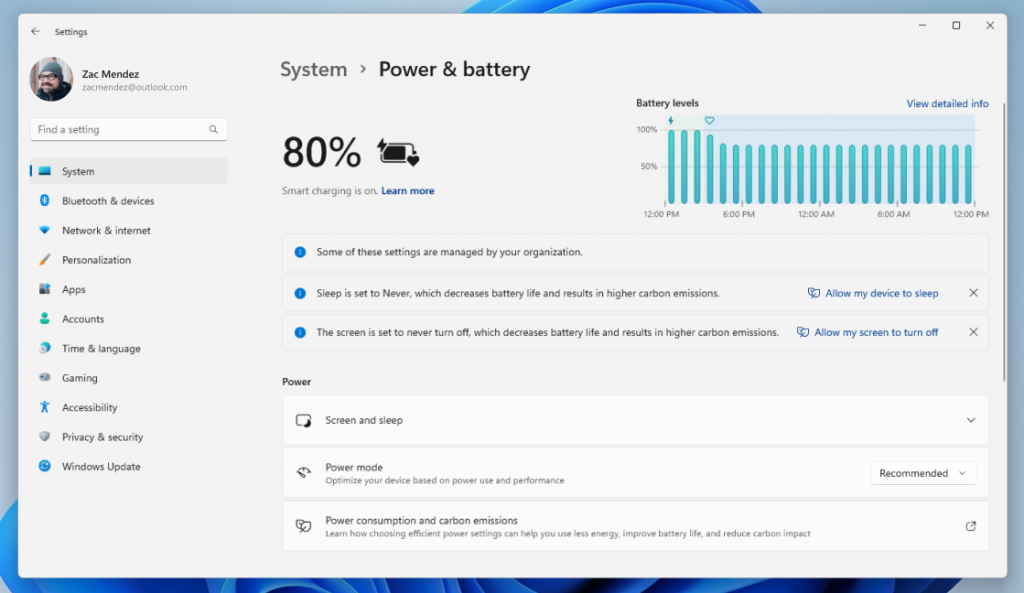
The changes to default Sleep and Screen off settings will only be seen by those clean-installing Windows 11 with this build or higher. If you intentionally set Sleep or Screen off to Never, please let us know why, especially if sleep is not working as expected. We’re still working on the content that the “Power consumption and carbon emissions” options links to – stay tuned for future updates.
FEEDBACK: Please file feedback in Feedback Hub (WIN + F) under Power and Sleep > Sleep (or use the link above).
More improvements to browsing the web in Microsoft Edge with Narrator
Building off the collection of improvements for Narrator and Microsoft Edge from Build 22509, we have been working on more improvements to web browsing with Microsoft Edge and Narrator. Specifically, when navigating the web more useful information is provided, navigating dialogs is more natural, and editing text should now be more reliable.
When navigating the web, you can have Narrator read the current item (e.g., current page, current time etc.) and when you need to sort a table on the web, Narrator will announce the sort order you’ve selected (e.g., ascending, descending).
We also made it simpler to know when an item is selected in a tree view control and to know the state of a checkbox when these are part of a list. We also improved link navigation, and you will find that tabbing through links on a webpage and pressing Enter will always take you to the link destination.
When you encounter a dialog box on the web, Narrator will help you stay focused within the dialog box and prevent navigation to the content that’s behind it. This improvement is currently available in Microsoft Edge Canary builds.
Lastly Narrator has a few improvements for when you are editing text on the web. First, if you are deleting text on a form field, Narrator will read the character that was deleted and if you need to cut a large set of text with Control + X, Narrator will confirm that the text has been cut.
FEEDBACK: Please file feedback in Feedback Hub (WIN + F) under Accessibility > Narrator.
Task Manager Redesign & Efficiency Mode
We have updated the design of Task Manager to match the new Windows 11 design principles. This includes a new hamburger style navigation bar and a new settings page. A new command bar on each page gives access to common actions. We are also excited to bring dark theme to Task manager and will automatically match the system-wide theme configured in the Settings app.
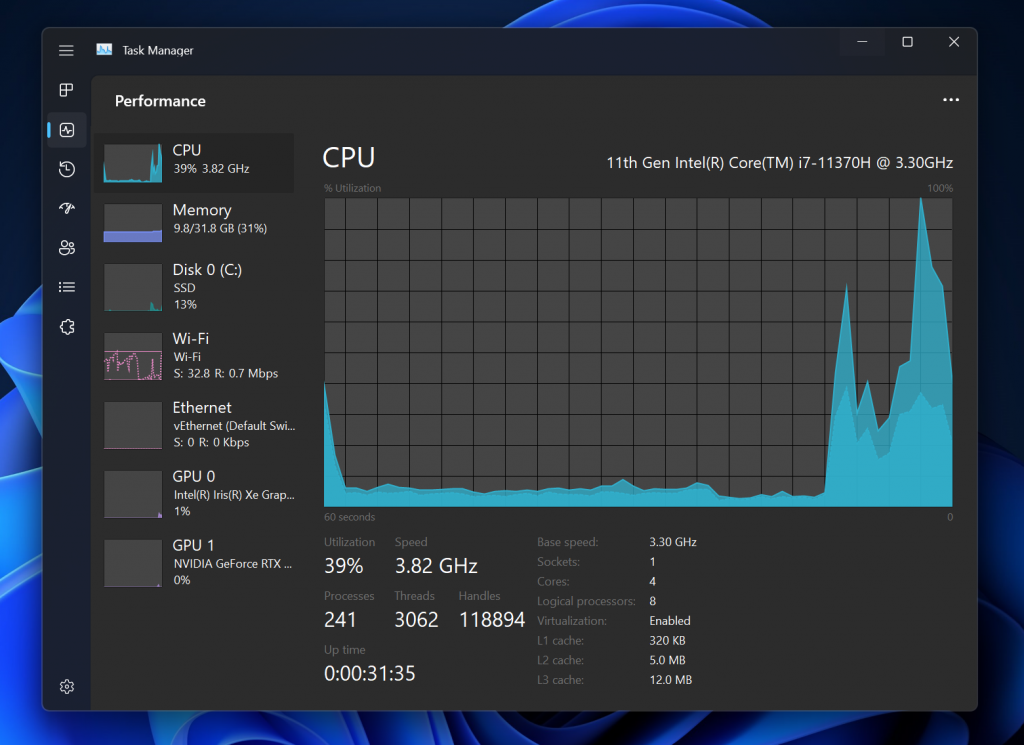
Last April, we experimented with a new feature called “Eco mode” in Task Manager and we’re bringing this back with a new brand name: Efficiency mode. This feature is helpful when you notice an app consuming high resources and would like to limit its consumption so that the system gives priority to other apps which will lead to faster foreground responsiveness and better energy efficiency.
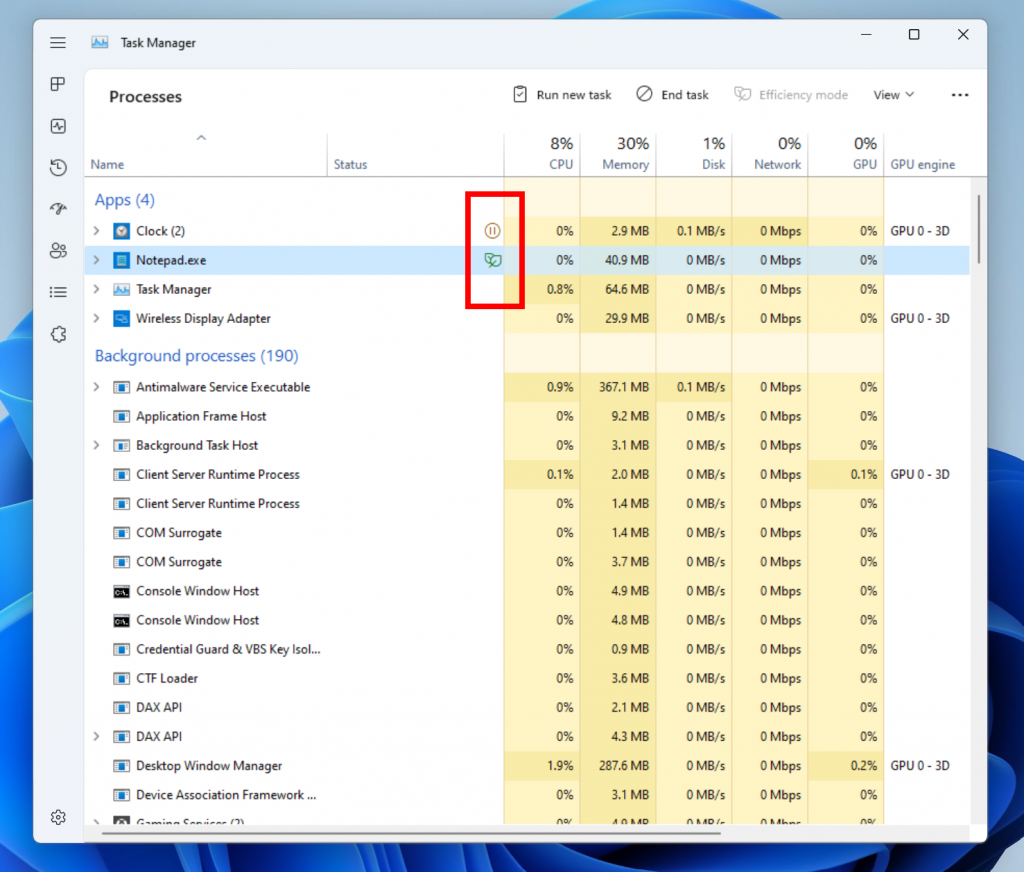
You can apply Efficiency mode either by clicking on the command bar in the Processes page or right click on the process. You can only apply Efficiency mode to single process and not to the entire group process. If the option is grey out, it generally means that it’s a core Windows process and throttling it might affect the performance of the system. The Efficiency mode process will be marked with a new leaf icon, and we are also introducing new pause icon for Suspended process to indicate the process is in suspended mode
[We are beginning to roll this change out, so it isn’t available to all Insiders just yet as we plan to monitor feedback and see how it lands before pushing it out to everyone.]
FEEDBACK: Please file feedback in Feedback Hub (WIN + F) under Desktop Environment > Task Manager.
Introducing a new PowerShell module to provision language and language related features
This new PowerShell Module allows users to easily add languages and related language features and manage settings like System Preferred UI Language, System Locale, Input method (Keyboard), Locale, Speech Recognizer, User Preferred Language List using the PowerShell prompt. These commands work in conjunction with the existing International PowerShell Module to provide the user control over various elements of the UI language on a PC.
Note: To run the Install and Set commands you must run PowerShell as an administrator.
| To do this | Command |
| Install a language on the PC. | Install-Language
Note: Please restart or log out and log back in for changes to take effect. Once you log back in, please change your Windows display language (WDL) via Settings > Time & language > Language & region to change the UI language on the PC. You can also change your WDL by using the international module commands (Set-WinUILanguageOverride ). Params: Language: The bcp47 tag of the language being installed. CopyToSettings (optional): If included, set the system and default device settings (WDL, regional, locale format) to the provided language following the installation. |
| Get a list of the installed languages on the device, which type of Language Pack is installed, and what Language Features are installed. | Get-InstalledLanguage
Alias: Get-Language Params: Language (optional): filters the list to only show the given language. |
| Set a language as the System Preferred UI Language | Set-SystemPreferredUILanguage
Alias: Set-PreferredLanguage, Set-SystemLanguage Params: Language: The bcp47 tag of the language being installed |
| Get the value of the current System Preferred Language. | Get-SystemPreferredUILanguage
Note: Please restart or log out and log back to see the changes reflected in the new language. Additional user accounts created on the same system will reflect the new system language. Alias: Get-PreferredLanguage , Get-SystemLanguage |
| Uninstall a language on the PC. | Uninstall-Language
Params: Language: The bcp47 tag of the language being installed. |
FEEDBACK: Please file feedback in Feedback Hub (WIN + F) under Apps > PowerShell.
Changes and Improvements
[Taskbar]
- Drag and drop is now supported on the Windows 11 taskbar. Quickly drag and drop files between app windows, by hovering over apps in the taskbar to bring their windows to the foreground. Try attaching a file to an Outlook e-mail by dragging it and hovering over the Outlook icon in the taskbar to bring the window to the foreground. Once in the foreground, drop your file into the e-mail to attach it. You can also customize your taskbar with your favorite apps from Start’s All apps list by dragging and dropping over the taskbar to pin them. You can also drag and drop to the desktop via “Show desktop” at the very right corner of the taskbar.
- For Insiders using Microsoft Teams for work and school that are using share any window from the taskbar, we have added a new visual indication to the taskbar that indicates which window is being shared. This is especially important when you have multiple applications running or where your attention is split across multiple monitors. When you choose to share a window in your Microsoft Teams call, the shared window will also now be surrounded by a colored border.

- On PC’s with more than one color profile, you will be able to add a quick setting to switch more easily between these modes. On clean install, the Color profile button should not be pinned by default, but it might appear on upgrades.
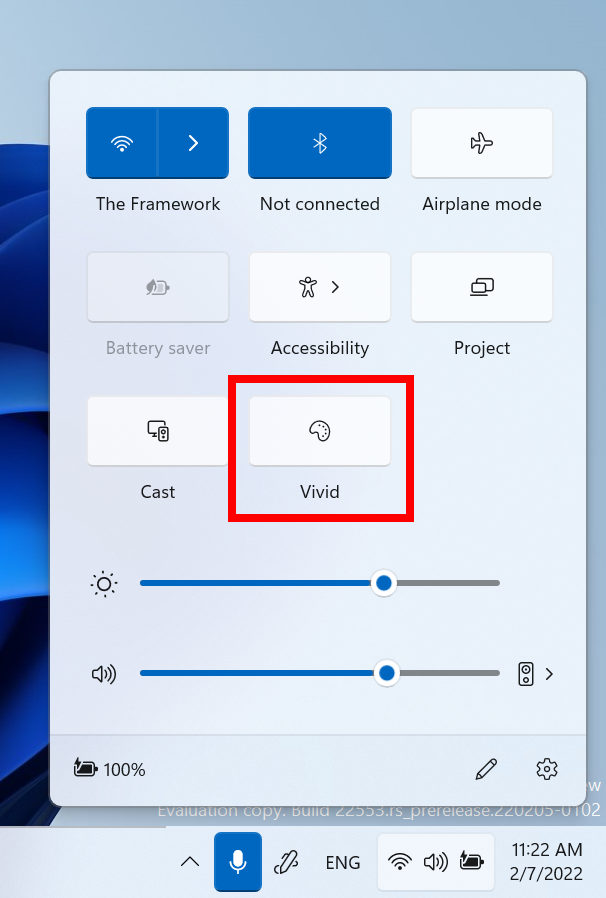
- When casting (WIN + K) from your PC, a Cast icon will appear at the lower-left corner of your taskbar to show you are casting. Clicking the icon will open the Cast Quick Settings where you can quickly stop casting if needed. And expect more improvements coming for this experience.
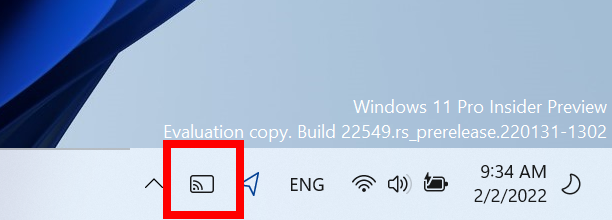
- As discovered by Insiders with Build 22543, we have updated the battery charging indicator to use a lightning bolt instead of a power cable. This addresses feedback that it was not possible to see lower charging levels at-a-glance because they were obscured by the cable. It’s also consistent with other consumer electronics devices and reflects the evolving landscape of charging to include USB charging devices.

[File Explorer]
- File Explorer will now show previews of items within folders.
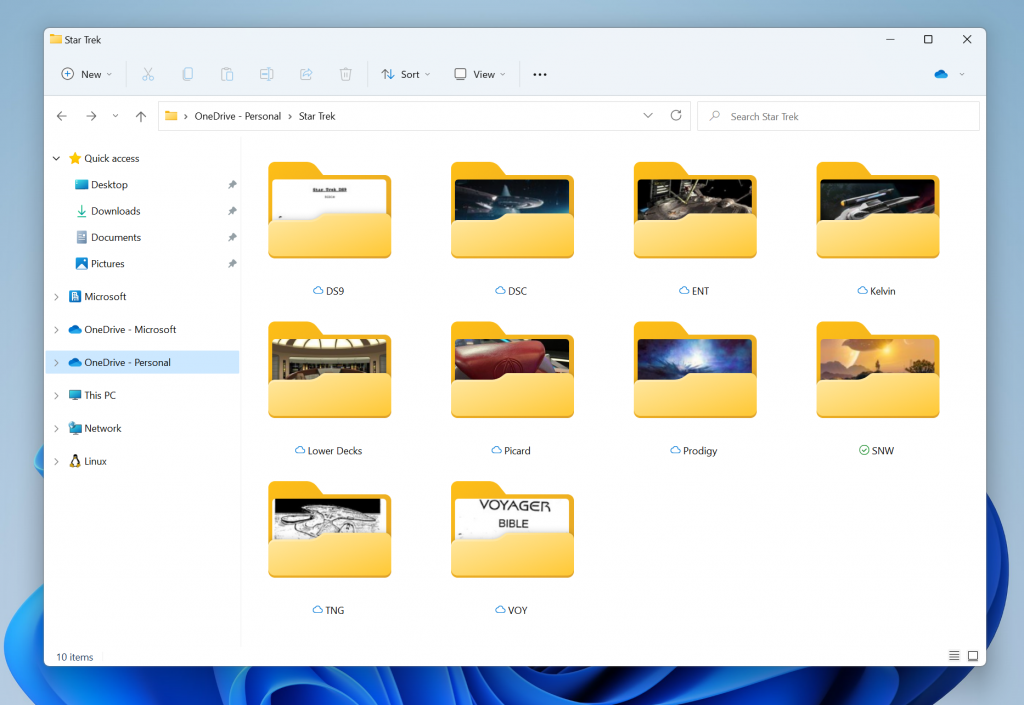
- When sharing a local file in File Explorer to Outlook – you can now compose an email message directly within the share window without having to go into Outlook directly. You will need Outlook Desktop Integration installed via the Store and this capability is not available for files stored in OneDrive folders as OneDrive has its own share experience. Also, the share window will now suggest contacts from Microsoft 365 to share the file to via Outlook.
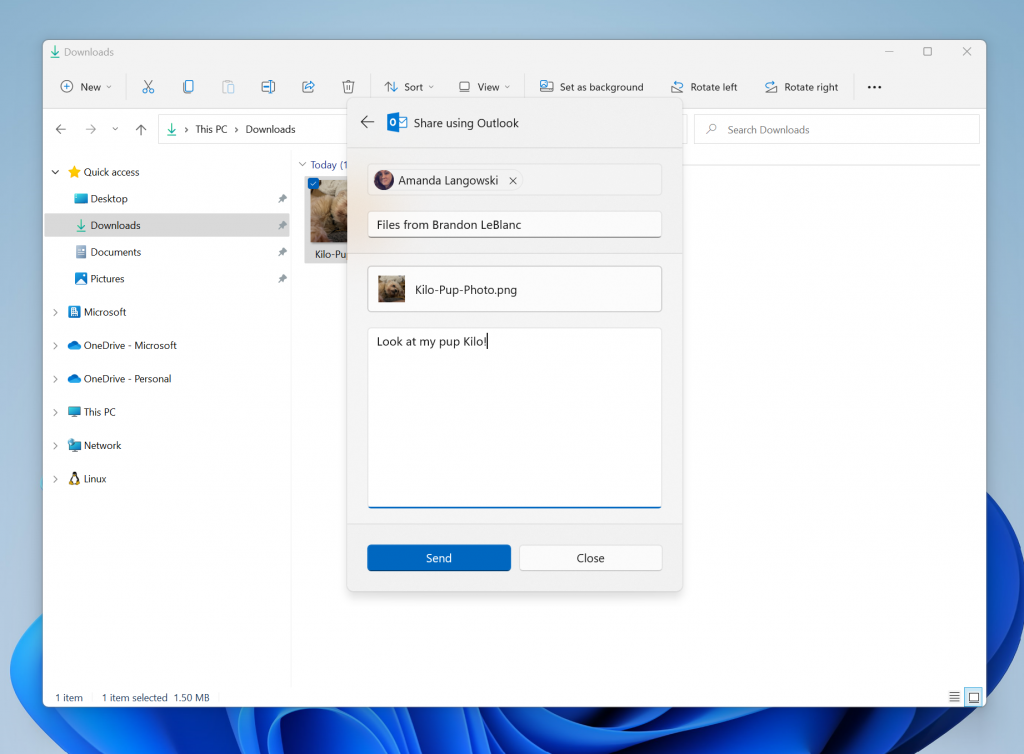
[Search]
- Searching for apps and settings in the Windows search box on the taskbar is now even faster and more accurate than before. Try searching for your favorite app or a setting you use frequently to see faster results. We’ve also fixed an issue that prevented Windows users from being able to search for an app in the first few seconds after it had been installed.
[Windowing]
- We have updated the snap group visuals to include the desktop wallpaper to make it easier to differentiate your groups from normal windows. This will appear when using ALT + TAB, Task View, and in the taskbar previews. Additionally, ALT + TAB will now show as windowed for all Insiders running Build 22554 and up.
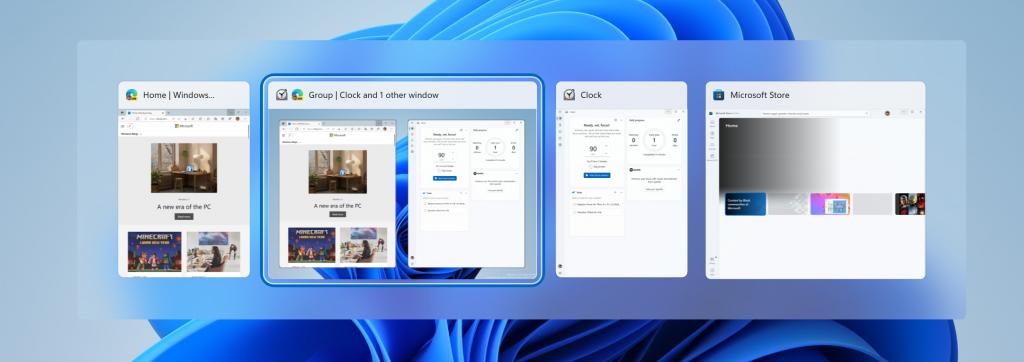
- We are updating the transition animation that shows going from one snapped window state to another. Snap some windows using the snap assist, move windows from one configuration to another and observe the fluidity of the transition with our new animations.
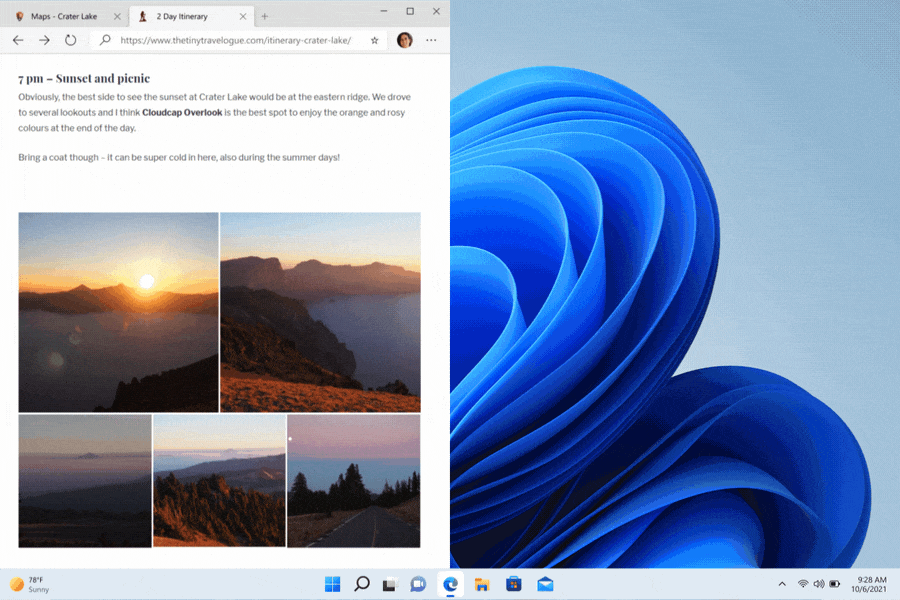
- Rotating your device between portrait and landscape orientation is snappier, more responsive.
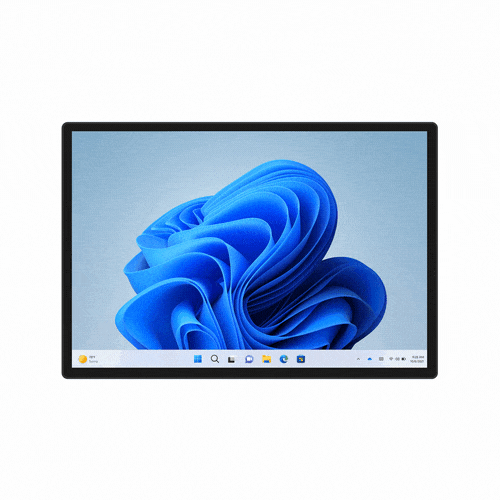
- We have reduced the number of notification sounds that play when you connect and disconnect docks and monitors.
- It is now easier to move your cursor and windows between monitors, by letting your cursor jump over areas where it would previously get stuck. This behavior is controlled in settings with System > Display > Multiple displays > Ease cursor movement between displays.
- We’ve made some small changes to the snapping options under System > Multitasking to help simplify them and make them easier to understand.
[Narrator]
- Narrator now provides a new male natural voice called Guy. We introduced new natural voices for Narrator in Build 22543.
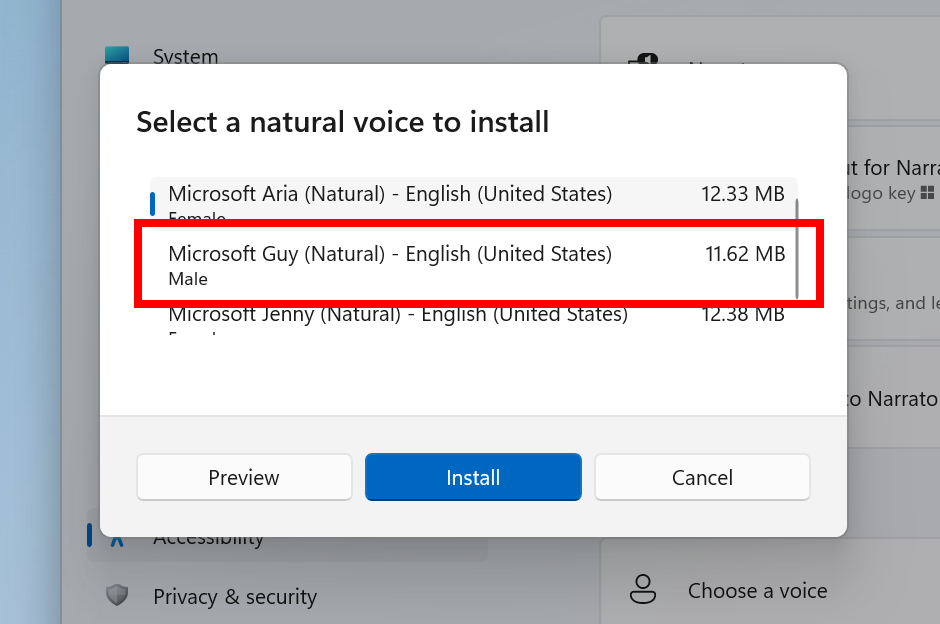
[Voice typing]
- We are adding the ability for you to choose which microphone to use in voice typing if you have multiple microphones connected to your PC. [We are beginning to roll this change out, so it isn’t available to all Insiders just yet as we plan to monitor feedback before pushing it out to everyone.]
- We are beginning to roll out the ability for you to use the following new commands in voice typing. [We are beginning to roll this change out, so it isn’t available to all Insiders just yet as we plan to monitor feedback before pushing it out to everyone.]
| To insert this | Say this |
| Enter | “Press Enter” |
| Backspace | “Pres Backspace”, “Backspace” |
| Space | “Press space”, “Insert Space” |
| Tab | “Press Tab”, “Tab” |
[Voice access]
- A new setting to add punctuation automatically when dictating text has been added. You can turn it on by clicking on the settings icon on voice access UI and selecting automatic punctuation from “manage options”.
- We added a new setting to filter profanity. This is on by default and any profane or sensitive words will be masked with asterisk (*) when dictating text or commanding. You can turn it off by clicking on the settings icon on voice access UI and selecting filter profanity from “manage options”.
- It is now easier to use “show numbers” command as we have reduced the occurrence of number labels hiding the controls on windows UI and making it hard to understand the control under a number.
- We improved feedback messages for unsupported languages.
- We also improved feedback messages for using voice access when you have multiple displays setup.
- We improved discoverability of using touch keyboard with voice to enter passwords or PINs, correcting mistakes, and spelling out words using “correct that” and “spell that” commands.
| To do this | Say this |
| Correct the last dictated text | “Correct that”, “Spell that” |
| Correct specific text | “Correct [text]”, “Spell [text]” |
[Graphics]
- We’re expanding Dynamic Refresh Rate (DRR) experiences on laptops with 120Hz displays beyond smooth scrolling in Office and low latency inking. When you move the cursor, the system will now boost to 120Hz, making your PC feel more responsive. Touch and pen interactions blend into smooth animations in Windows UI and apps UI. Smooth scrolling is now supported not only in Office, but also in Microsoft Edge Canary and Windows UI such as the Settings app. To enable smooth scrolling on Edge Canary you need to enter the following in the address bar of a new tab: “edge://flags/#edge-refresh-rate-boost-on-scroll”, set the highlighted flag to ‘Enabled’ and then restart Edge.
- The Windows HDR Calibration app is coming to Windows PCs soon – you’ll be able to improve color accuracy and consistency on your HDR display. For easier access, you’ll be able to access this app via the Windows settings under System > Display > HDR You may see an early access point in HDR settings in this build, but as the app is not live yet, it will simply lead you here.
- This build introduces a feature called Optimizations for windowed games and is designed to significantly improve latency and unlock other exciting gaming features including Auto HDR and Variable Refresh Rate (VRR). Latency improvements can benefit all gamers – from improving your input lag to creating a competitive edge in your gaming experience. Go to System > Display > Graphics > Change default graphics settings to enable the feature. Note that this feature may be already on by default and is also required to use other graphics features such as Auto HDR. To learn more, check out https://aka.ms/WindowedGameOptimizations.
[Input]
- We’re working on adding an IME On/Off key to the touch keyboard small layout for the Japanese, Korean, and Chinese Traditional IMEs. For Insiders with only one keyboard this will be a standalone key on the left of the space key. If you have multiple keyboards the On/Off key is combined with voice typing – to access voice typing, simply press and hold the key. In addition, we’re adding small layout support for the Chinese Simplified Microsoft Pinyin and Microsoft Wubi IMEs. These changes are currently rolling out to a subset of Windows Insiders at first and we’ll expand over time based on feedback.
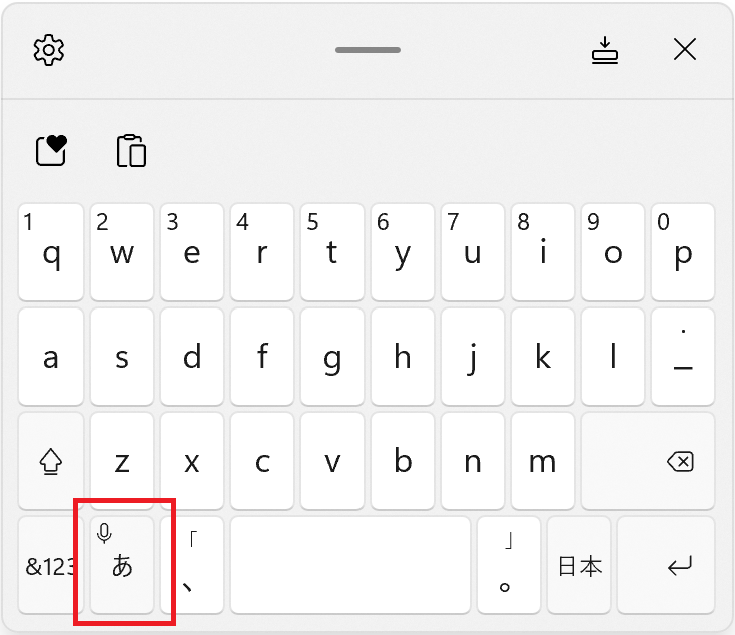
- Updated some of the emoji based on feedback, including the smile with tear emoji, sakura emoji, and colored heart emojis.
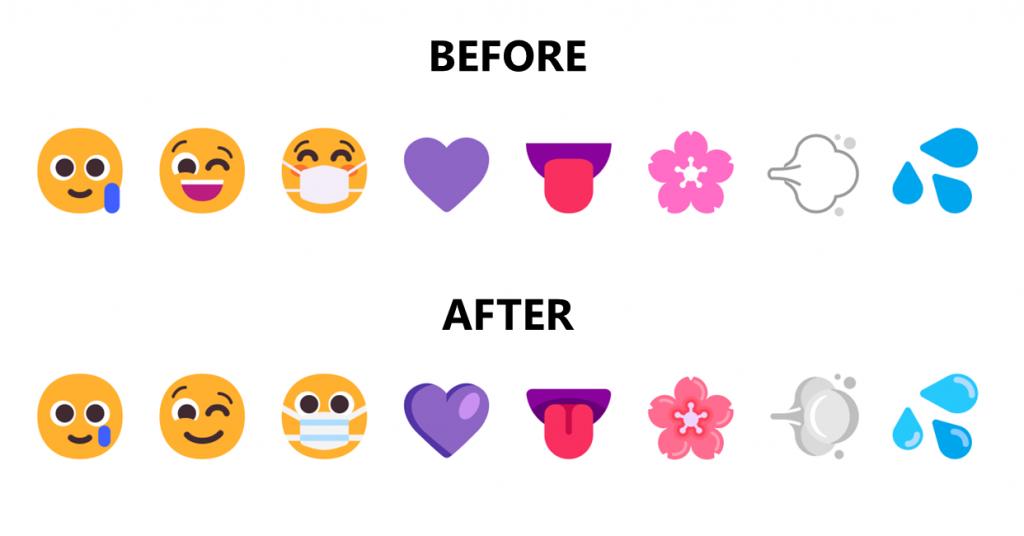
- Added a few new items to the kaomoji section in WIN + Period(.) based on feedback, including UwU.
- Windows 11 now supports Hungarian for handwriting input as of this build. Pick up your pen and write using Hungarian in the handwriting input panel or handwriting keyboard, and have your handwriting be converted to text.
[Settings]
- We’ve done some work to generally improve results when searching in Settings, including more relevant results and now have some flexibility for returning results in the case when the search terms have common typos.
- We’ve increased the size of the icons in the Settings navigation pane to make them a bit easier to see.
- To help customers give their PC a second life, or recycle it, we are including links in Settings to help customers find available programs. Some articles may not be localized.
- Storage Sense will now be enabled by default for PCs going through OOBE. Your current settings will be persisted on upgrade. You can configure your Storage Sense settings under System > Storage.
- Updated Settings Time & Language category and Date & time page to now include a live digital clock and information about currently selected option.
- Updated the design of Network & Internet > Dial-up when you have a connection set up to align with the overall design of Settings in Windows 11.
- We’ve made some adjustments to Personalization > Fonts to improve the design of the page, including that the drag and drop area for installing fonts is larger now.
[Windows Sandbox]
- Aligning with Hyper-V behavior, even if you’re not in full screen mode, modifier keys and shortcuts (for example Windows key shortcut) will now be intercepted by Windows Sandbox if the window has focus.
- Windows Sandbox now supports basic environment variable usage (like %USERPROFILE%) inside in mapped folder paths.
[Other changes]
- We have updated the accessibility flyout on the login screen to align with Windows 11 design principles.
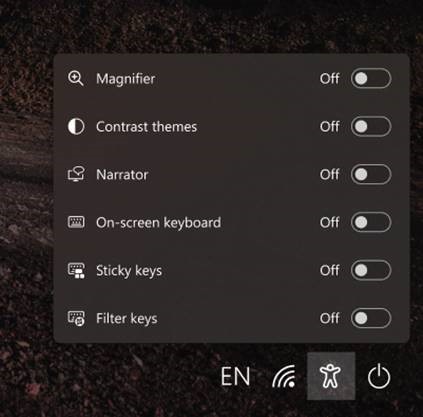
- Insiders will notice the Mica material in more title bar surfaces. For example, the Run dialog now utilizes Mica.
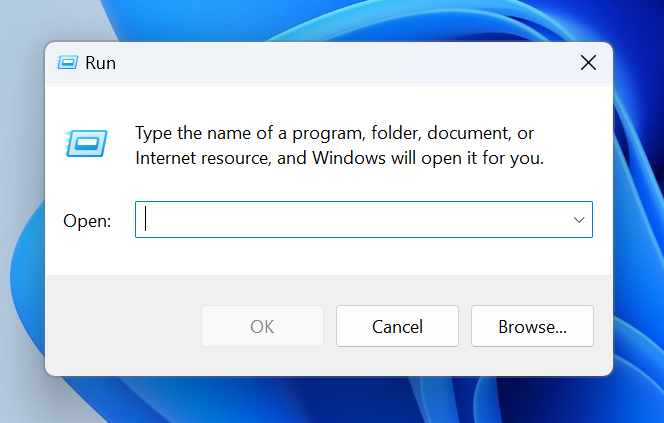
Semelhante à edição do Windows 11 Home, a edição do Windows 11 Pro agora requer conectividade com a Internet apenas durante a configuração inicial do dispositivo (OOBE). Se você optar por configurar o dispositivo para uso pessoal, o MSA também será necessário para a configuração. Você pode esperar que a Conta da Microsoft seja necessária em voos WIP subsequentes.
Conserta
[Em geral]
Corrigido um backgroundTaskHost.exe recorrente que alguns Insiders estavam enfrentando.
Corrigido um problema que fazia com que o HDR automático não fosse ativado como esperado em certos jogos.
Atenuou uma falha do lsass.exe que estava resultando em alguns Insiders vendo falhas na tela de login em voos recentes.
Abordou um problema que estava levando a áudio visivelmente distorcido para dispositivos de áudio conectados usando o Adaptador Sem Fio Xbox em voos recentes.
[Barra de tarefas]
A Exibição de Tarefas não deve mais travar se você segurar CTRL enquanto passa o mouse sobre ela.
Arrastar um arquivo pela barra de tarefas em monitores secundários não deve mais causar uma falha do explorer.exe.
[Explorador de arquivos]
Atualizado o botão Uso de armazenamento na caixa de diálogo Propriedades para um disco agora ser chamado de Detalhes e um pouco mais amplo, para acomodar idiomas em que o texto do botão estava sendo truncado.
Melhorou o desempenho de exclusão de arquivos na Lixeira.
Corrigido o ícone do Blu-ray para que ele se alinhe com os outros ícones de unidade e volume.
[Entrada]
Resolvido um problema em que a janela do candidato IME inesperadamente não seguia sua preferência de modo claro ou escuro.
Corrigido um problema que fazia com que alguns elementos do submenu das configurações de digitação por voz ficassem invisíveis no modo escuro.
A janela do candidato IME deve aparecer como esperado agora no campo de nome de usuário de um prompt do UAC.
Atualizado o termo “Halfwidth alphanumeric / Direct Input” para dizer apenas “Halfwidth Alphanumeric” no menu de contexto do IME japonês.
Corrigido um problema em que, após digitar hiragana no modo de entrada Kana, se houvesse um caractere alfabético de meia largura antes do hiragana na composição, ele inesperadamente se tornaria de largura total.
Resolvido um problema raro em que o alternador de entrada pode listar inesperadamente a mesma entrada duas vezes.
Atenuou um problema que levava a uma caixa preta inesperada que às vezes aparecia no alternador de entrada.
Atualizado o alternador de entrada para que ele fique um pouco mais alto agora para pessoas com mais de 4 teclados.
Corrigido um vazamento de memória no alternador de entrada que levava à falha do explorer.exe após o uso rápido repetido.
Corrigida uma falha do explorer.exe ao clicar em Mais configurações de teclado no alternador de entrada.
Corrigido um problema em que o painel emoji pode mostrar "você está offline" mesmo que você tenha conectividade de rede.
Corrigido um problema em que o emoji de multiplicar emoji e o emoji do botão de setas no sentido anti-horário exibiam o design do emoji errado.
Atualizada a visualização na página Personalização > Configurações de entrada de texto para refletir o papel de parede da área de trabalho em vez do padrão.
Fez algum trabalho para melhorar a confiabilidade da tecla Parar mídia quando a mídia está sendo reproduzida.
[Acesso por voz]
Corrigimos uma incompatibilidade do Visual C++ Runtime que fazia com que o acesso de voz não fosse executado em alguns PCs.
[Procurar]
Corrigida uma falha de pesquisa de alto impacto.
Clicar na caixa de pesquisa em Iniciar agora alternará imediatamente para Pesquisar sem mostrar a janela de pesquisa animada para cima, assim como quando você pressiona a tecla Windows e começa a digitar.
[Configurações]
Resolveu um problema em que o Narrador não estava lendo os elementos de Sistema > Armazenamento corretamente.
Corrigido o link "tamanho e tema" quebrado em Hora e idioma > Digitação > Teclado de toque.
Fez algum trabalho para ajudar a melhorar o desempenho ao atualizar a cor ou o modo de destaque.
Fizemos uma alteração para ajudar a reduzir o recorte em caixas de combinação em Configurações para determinados idiomas e tamanhos de texto.
Corrigido um problema que fazia com que os ícones nas páginas de configurações do IME às vezes ficassem brancos no branco.
Atenuou um problema que fazia com que o botão de instalação tivesse texto truncado em alguns idiomas ao visualizar fontes.
Corrigida uma falha subjacente que fazia com que o vídeo de visualização em Sistema > Tela > HDR às vezes ficasse distorcido.
Abordou um problema subjacente que poderia fazer com que as configurações travassem quando você rolasse a janela.
Ajustado o ícone Wi-Fi na seção Wi-Fi das Configurações rápidas para que o bloqueio mostrado para uma rede segura agora tenha uma pequena separação da força do Wi-Fi, tornando-o um pouco mais fácil de distinguir.[Destaque do Windows]
Atualizado o nome da coleção Spotlight para Windows Spotlight, para que seja consistente com a tela de bloqueio.
Fizemos uma alteração para ajudar a tornar as imagens de atualização do Windows Spotlight mais confiáveis.
Em vez de mostrar um plano de fundo de cor sólida, se por algum motivo novas imagens do Windows Spotlight não estiverem disponíveis para a área de trabalho, ele agora voltará a mostrar a imagem de plano de fundo padrão do Windows Spotlight (Whitehaven Beach).
Clicar com o botão direito do mouse em “Saiba mais sobre esta imagem” do Windows Spotlight na área de trabalho agora sempre mostrará todas as opções, apenas acinzentadas se não estiverem disponíveis no momento.
Ao passar o mouse sobre “Saiba mais sobre esta imagem”, a dica de ferramenta agora deve se alinhar de forma mais consistente com a imagem atual.
[Janela]
Resolvido um problema que fazia com que os botões minimizar, maximizar e fechar no Explorador de Arquivos e alguns outros aplicativos ficassem invisíveis em determinados casos.
Atenuou um problema que causava impacto no desempenho ao arrastar janelas com acrílico e outros cenários com acrílico.
Você não deve ver uma borda amarela aomais tirar screenshots.
- Fizemos algumas melhorias para resolver o feedback de que as janelas estavam reposicionando inesperadamente.
[Rede]
Fez algum trabalho para resolver um problema que pode fazer com que certas conexões VPN falhem. Se você continuar tendo problemas, envie comentários com uma captura do problema em Rede e Internet > Conectando-se com um cliente VPN.
Corrigido um problema que levava à diminuição da velocidade do Wi-Fi depois de acordar seu PC do modo de suspensão no voo anterior.
[Narrador]
Ao retroceder, o Narrador agora anunciará de forma mais consistente quando você estiver excluindo caracteres com retrocesso.
Corrigido um problema que fazia com que o Narrador não lesse o texto selecionado no Hub de Feedback.
OBSERVAÇÃO: algumas correções observadas aqui nas compilações do Insider Preview da ramificação de desenvolvimento ativa podem chegar às atualizações de serviço para a versão lançada do Windows 11 que se tornou disponível em 5 de outubro de 2021.
Problemas conhecidos
[Em geral]
Ao passar pela experiência de configuração do dispositivo (OOBE) na edição Enterprise, a tela de adição de rede será ignorada na primeira tentativa. Como solução alternativa, quando os usuários virem a opção “nomear seu computador”, reinicie e reinicie o OOBE. A tela de adição de rede agora aparecerá conforme o esperado.
[Começar]
Os nomes dos aplicativos nas pastas podem aparecer borrados brevemente ao abrir pastas em Iniciar.
[Barra de tarefas]
A barra de tarefas às vezes piscará ao alternar os métodos de entrada.
[Explorador de arquivos]
As pesquisas do Acesso Rápido podem não funcionar.
Estamos trabalhando para corrigir problemas relacionados ao dimensionamento de ícones, bugs visuais e recorte de texto no submenu que mostra o armazenamento do OneDrive.
[Foco]
O ícone da barra de tarefas e a dica de ferramenta podem não corresponder ao estado de foco.
A integração do aplicativo Relógio requer uma atualização do aplicativo que está começando a ficar disponível hoje. A maioria dos usuários deve obter essa atualização automaticamente, mas você pode verificar as atualizações do aplicativo manualmente navegando até Microsoft Store > Biblioteca e clicando em Obter atualizações.
O aplicativo Relógio ainda não atualiza o estado do Windows Focus ao configurar sessões de foco no aplicativo. Isso será abordado em uma futura atualização do aplicativo.
[Procurar]
Depois de clicar no ícone Pesquisar na barra de tarefas, o painel Pesquisar pode não abrir. Se isso ocorrer, reinicie o processo do “Windows Explorer” e abra o painel de pesquisa novamente.
[Widgets]
Com a barra de tarefas alinhada à esquerda, informações como temperatura não são mostradas. Isso será corrigido em uma atualização futura.
[Legendas ao vivo]
Certos aplicativos em tela cheia (por exemplo, players de vídeo) impedem que as legendas ao vivo fiquem visíveis.
Certos aplicativos posicionados perto da parte superior da tela e fechados antes da execução das legendas ao vivo serão reiniciados atrás da janela de legendas ao vivo posicionada na parte superior. Use o menu do sistema (ALT + Barra de espaço) enquanto o aplicativo estiver em foco para mover a janela do aplicativo mais para baixo.
O topo dos aplicativos maximizados (por exemplo, botões de gerenciamento da janela da barra de título) não pode ser alcançado com o toque enquanto as legendas ao vivo estão posicionadas no topo.
[Gerenciador de tarefas]
Estamos cientes de que o ícone do modo de eficiência está ausente em alguns processos filho.
Algumas opções de configuração não são preservadas.
Estamos trabalhando para corrigir problemas relacionados ao tamanho do ícone, bugs visuais e, na maioria dos casos, a solução alternativa é redimensionar o Gerenciador de Tarefas ou diminuir as configurações de resolução em Configurações> Tela> Resolução da tela.
O Gerenciador de Tarefas tem suporte limitado ao teclado na navegação e na barra de comandos. Os usuários podem não conseguir navegar na interface do usuário usando o teclado devido ao suporte limitado.
Para desenvolvedores
Você pode baixar o SDK do Windows Insider mais recente em aka.ms/windowsinsidersdk.
Os pacotes SDK NuGet agora também estão em voo na Galeria NuGet | WindowsSDK que incluem:
Pacotes .NET TFM para uso em aplicativos .NET conforme descrito em ms/windowsinsidersdk
Pacotes C++ para cabeçalhos e bibliotecas Win32 por arquitetura
Pacote BuildTools quando você só precisa de ferramentas como MakeAppx.exe, MakePri.exe e SignTool.exe
Esses pacotes NuGet fornecem acesso mais granular ao SDK e integram-se melhor em pipelines de CI/CD.
Aplicativo Seu telefone: acesse seus aplicativos Android recentes mais rapidamente
Temos o prazer de anunciar outro recurso para o aplicativo Seu Telefone. Para aqueles com dispositivos Samsung, agora você pode desfrutar de mais continuidade ao passar do telefone para o PC. Com esta adição mais recente, você pode acessar facilmente os aplicativos usados recentemente em seu dispositivo Android em seu PC com Windows.
Seus aplicativos Android usados recentemente exibidos na barra de tarefas.
Seus aplicativos Android usados recentemente exibidos na barra de tarefas.
Você pode acessar os três aplicativos usados mais recentemente no seu Android selecionando o ícone Seu telefone na barra de tarefas do Windows. Você também pode encontrar uma nova seção de aplicativos recentes na página de aplicativos no aplicativo Seu Telefone. O recurso agora está disponível para todos os Windows Insiders em todos os canais Insider com dispositivos Samsung selecionados (detalhes abaixo). Experimente e diga-nos o que pensa!
Requisitos de aplicativos recentes:
Para usar aplicativos recentes, você precisará